Bayern Munich are well known on the men’s side of the sport for their domination domestically. Year in year out they are the overwhelming favourites to claim the silverware on offer. However, on the women’s side, things are slightly different. VfL Wolfsburg have claimed the summit of the Frauen Bundesliga for some time now. They have one each of the last three league titles, and five out of the past seven. Bayern have been the only team to break Wolfsburg’s hold in this time, winning consecutive titles in the 2014-2015 and 2015-2016 campaigns.
In this tactical analysis scout report on Bayern Munich, we will take an in-depth look into their side and tactics. We will begin by looking at their structure and strengths of play, before going into the areas they have to improve upon to overtake their rivals once more to bring the league title back to Munich.
General set-up
Typically, we will see Bayern Munich utilise two main formations. The 4-4-2 and 4-2-3-1 are used over 60% of the time, and this majorly revolves around the implementation of their double pivot system. This midfield allows them to have success getting forward using the tactics we will go into detail about later in this piece.
At the centre of what Bayern work to implement is the use of the double pivot midfield system. While they will sometimes opt for formations such as the 4-3-3 or 4-3-2-1, these are often used against specific opponents and how they are set up to defend against Bayern.
Even with a three in midfield, the main concepts used remain the same. The midfield keeps compact in order for the side to be expansive down the channels. As we will look at in this next section, Bayern look to overload the wide areas using their full-backs in order to break deep blocks in these areas, rather than trying to work possession through the centre of the pitch, where sides are better able to be compact.
Attacking the channels
Bayern Munich look to use their full-backs a significant amount in generating their attacking movements. As mentioned above, Bayern’s midfield set-up is a major part of these players having the freedom to play in such a manner. In this section, we will explain how this tactical set-up does this, and how Bayern utilise it.
The use of a double pivot is often most effective in giving full-backs the freedom to push forward into the attack. In major teams around the world, we can see the style of pivot used is normally dictated by the type of style the team uses. Jumping over to Pep Guardiola’s Manchester City team on the men’s side, they use a single pivot in their midfield. This is because most of their attacking intention comes through building possession into the more advanced number eight’s in the centre of the pitch. From here they will then look for opportunities to play out wide to their wingers, where they will typically be in one-v-one situations with their opposing full-back. With the attacking nature of this midfield structure, the full-backs are often used to tuck into the defensive structure to add solidity to the side against counter-attacks when possession is lost. The full-backs will still get forward but it is more situational.
Jean-Luc Vasseur’ Olympique Lyonnais side are built on the foundation of a double pivot in midfield. This structure is very similar to Bayern’s. Lucy Bronze and Alex Greenwood are two of the most effective attacking full-backs in the world, and they are given total freedom to move forward up the pitch to combine with the wingers. The double pivot holds their position in front of the defence to provide the protection against counter-attacks. These players are able to hold back because Lyon look to move possession forward using wide areas, rather than through the middle the majority of the time as we discussed with Guardiola’s side.
The same type of set up can be seen with Bayern Munich. As we mentioned in the initial section, regardless of the formation used by the German club, the intention of the midfield structure is to allow the full-backs the freedom to move forward. The likes of Simon, Gwinn, and Hendrich are all extremely dangerous from these deep positions. This has effects on how the side can set up further up the field as well. With the full-backs providing the width for the side quite often, the wingers are able to move into the middle of the pitch and make up for the lack of two advanced midfielders in this central area.
One specific role that is evident in Bayern’s system for the central midfielders is actually to drop into the position of a traditional full-back. This tactic presents a couple of difficulties for the opposition in terms of marking this Bayern system. Without the central midfielder making this movement, the outside midfielder for the opponent is able to drop deep with Bayern’s full-back and keep her marked. However, once the central midfielder takes this position away from her normal marker, it now forces the opposing wide midfielder to make a decision on who to mark.
The outside midfielder has two options. She can continue to track back with the full-back. The problem with this would be the potential of the central midfielder picking up possession now in plenty of space and able to move forward and look for ways to move the opponent’s defensive block. The outside midfielder can also stay forward and mark this central midfielder. However, with this, the attacking full-back is now free to move up the pitch unmarked and create a numerical superiority with her winger.
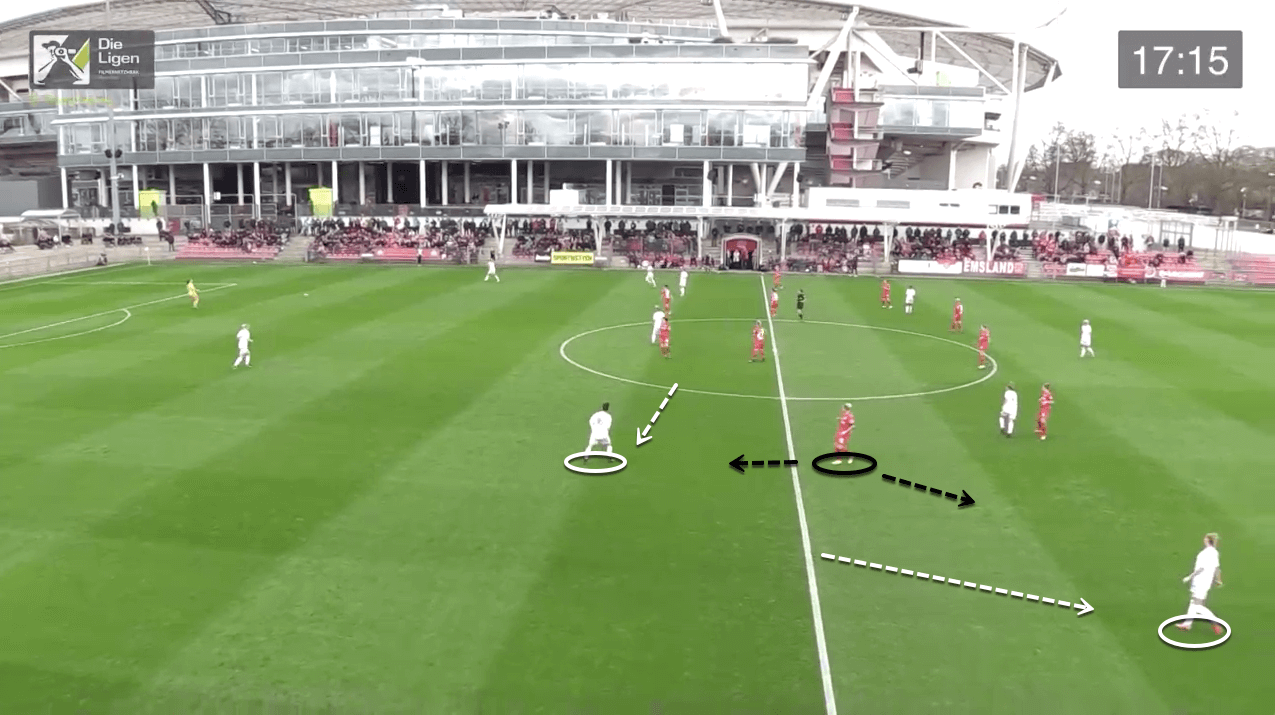
In the image above, we can see an example of this. Magull has dropped in from her central midfield position to the space on the right side of the defensive set-up. Acknowledging this, Gwinn moves forward to be in line with Bayern’s attack. You can see this decision the opposition’s outside midfielder now has to make. If she follows Gwinn, Magull will be left totally unmarked and able to dribble forward into the middle of Bayer Leverkusen’s defensive system.
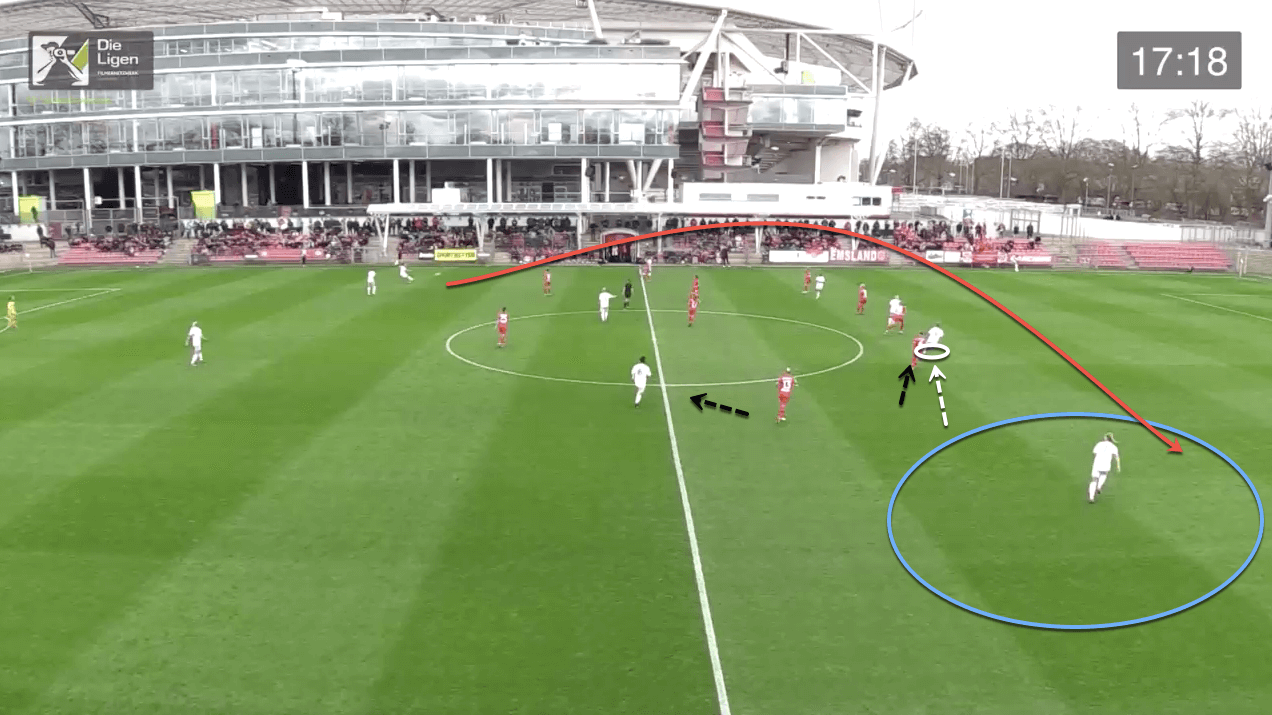
The opponent opts to hold her position and defend Magull. Gwinn wastes no time in moving forward. Beerensteyn acknowledges the situation and moves centrally to pull her marker away from this area, and Gwinn is left free down the right to receive a cross-field pass in behind the defence.
Covering the centre in transition
When Bayern Munich loses possession, it is essential that they remain compact in order to not allow a dangerous counter-attack to come about. To do this, the German club are extremely effective in suffocating their opponents as they look to get forward. As we have shown previously, with the two central midfielders protecting the centre-halves, Bayern’s counter-pressing structure is box-like. With this, Bayern like to utilise a well-known concept of forcing possession into space where the help defence is.
When an opposition attacker runs forward, the midfielders in the first line of counter-pressing will look to guide the player into areas where her partner in midfield and centre-half are able to assist. If this is successful, the counter-press has the ability to close in and suffocate the player in possession and not allow them to move forward.
Bayern will try and win back possession using this as quickly as possible. So far this campaign, they have a PPDA of 6.72. This emphasises their focus on pinning oppositions into areas where they are able to get in a tackle or make an interception. If they are able to find success using this, they will quickly look forward to identify potential holes in the opponent’s structure as they begin to push forward to try and relieve pressure.

In the image above, Bayern have lost possession and SGS Essen are looking to counter quickly while Bayern still have numbers forward. The player in possession receives the pass and quickly looks for options forward. The Bayern defender does a wonderful job in closing down the space she has in front of her and forcing the player in possession to look for teammates in the centre of the pitch for support.
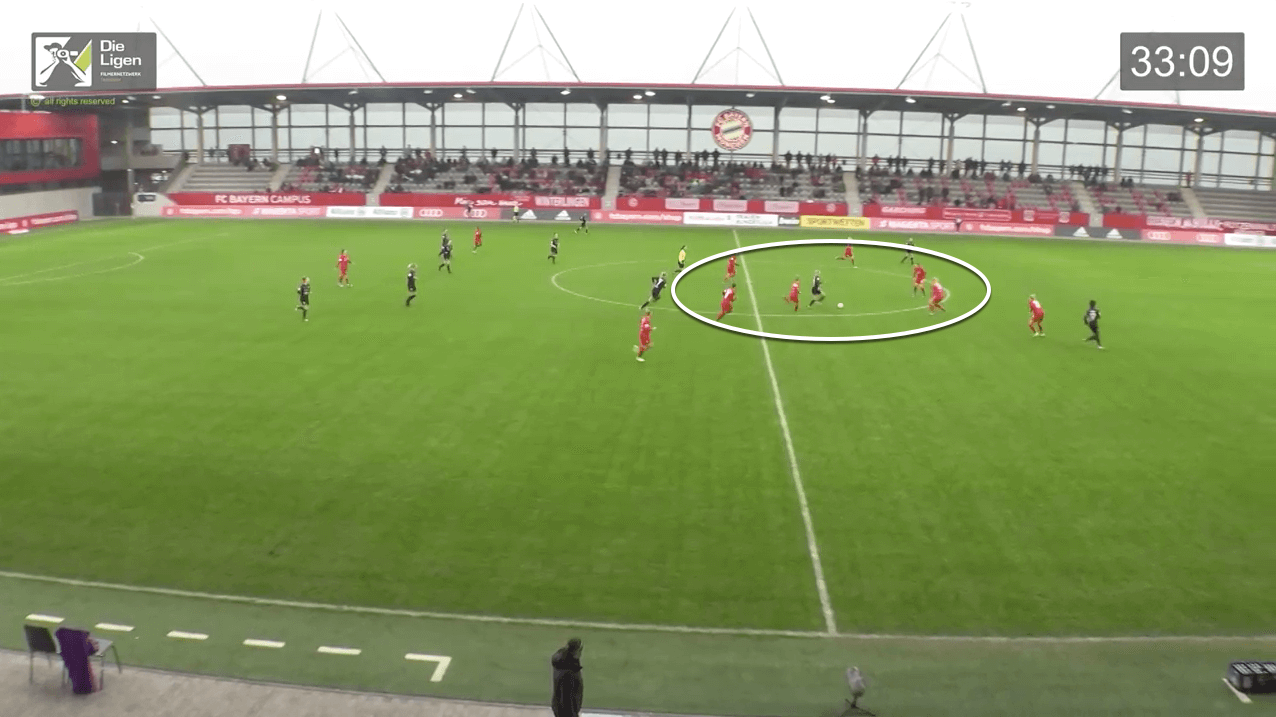
When this pass is played, Bayern’s defensive structure collapses in on the player in possession. She is being tracked closely from behind, and as soon as a hard touch is made, the centre-half steps forward to intercept. It is worth noting as well that the initial defensive move to hold up the SGS Essen player in the first picture gave Bayern enough time to get a good amount of players back in a defensive position. Even if this counter-pressing set up was not successful, Bayern had enough players back to deal with the attack.
Issues with high line
Moving to the other side, there are a couple of weaknesses to this Bayern team that have been exposed throughout the campaign. One issue we have seen is involving their backline. It is a given that with the way they look to play that there will be times that they are caught out at the back. However, tactical alterations could help reduce this issue in the future.
While Bayern’s counter-pressing scheme is effective most of the time, the issue lies when it is not. If an opponent can bypass this press, they will typically look to find a teammate out in a wide area. Here, Bayern are at their weakest, as the full-backs are pushed forward in attack. This results in the counter-pressing structure being forced to become very spread out. The centre-halves will normally have to be the ones to move out and meet the opponent as they are still behind the ball, which forces the central midfielders to have to work to get back into the central areas to block off runs into the box.
In the image you can see below, Bayern are in their defensive shape. A ball is played across the pitch to the player circled in white. Once she settles it, her teammate immediately looks for space to exploit.
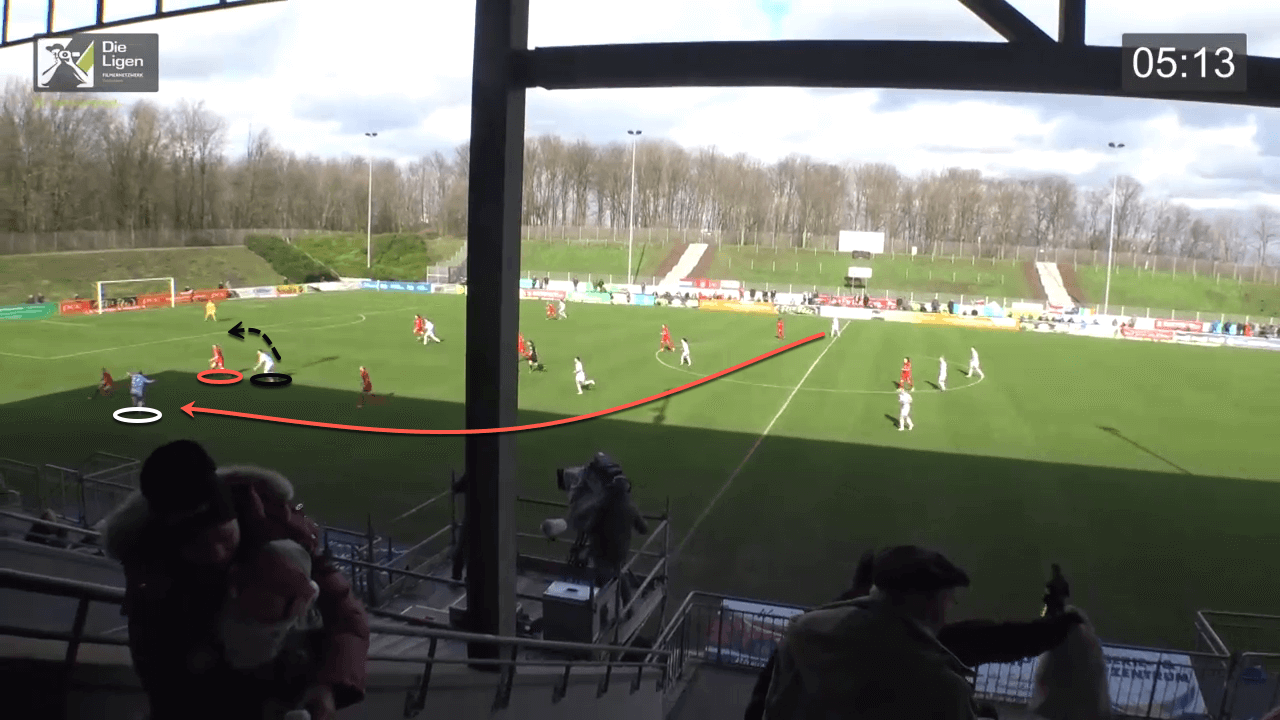
She quickly moves around her centre-half marker and looks to get in behind. Bayern are caught out in a situation where they have numerous chances to sort their shape out. When the initial long ball was played in the first picture, Bayern’s defensive line stayed too high. While the full-back wanted to press the player as she received the pass, the centre-half should have backed off to cover the full-back.
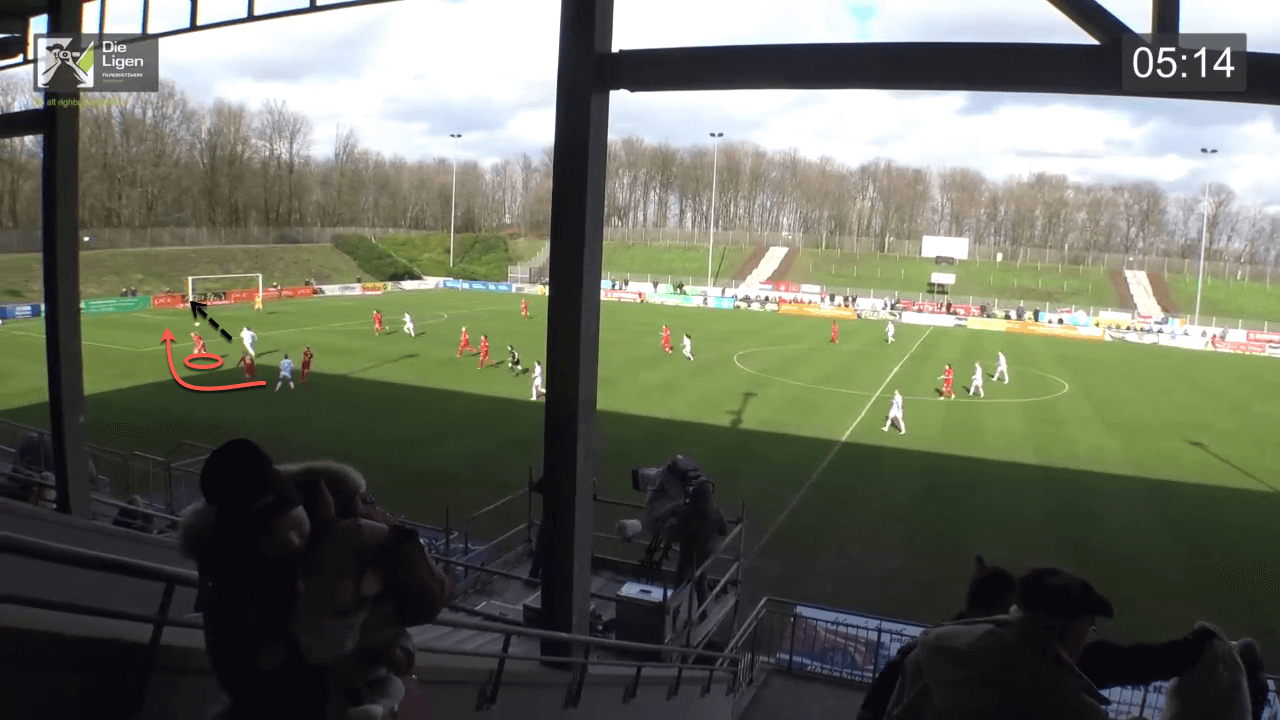
When the run started to be made, the centre-half was once again too late to react. It was not until after the ball was played over the top that she altered her body shape to track back and defend the run, which by that point the attacker already had the better of her and was able to get in behind successfully.
One change we could see to help this issue could be a tactical alteration with the structure. When in possession, moving a central midfielder into the middle of a back three with the centre-halves could solve a couple of these problems. While losing a player in midfield at times, with Bayern’s emphasis on getting possession into wide areas, this could be dealt with. Mixing that with the defensive solidity that it would bring would make for a good case for this change.
The holding midfielder’s job would not change much. Her role would be to move the opponent’s attack into an area where she has help from her other defenders. The extra player in the defensive line will come into effect majorly when this initial press is bypassed. This would allow the two centre-halves to have more ground covered, as their initial positioning would already be wider than previously, making it easier to block off passes out wide or close them down when they reach these areas. The central midfielder occupying the central centre-half position is already set up to mark any runs into the box or to step forward and press the ball-carrier should the opportunity to make a tackle or interception present itself.
Looking at this, Lena Oberdorf of SGS Essen could be the perfect fit for this type of role. Her flexibility has shown her to be able to play the centre-half and central midfield role extremely effectively. This would be perfect for a position in this Bayern Munich side that could rotate between the two. Her intelligence already at 18-years-old would allow her to be able to move between the different roles depending on what her side needed in the situation. The link above will take you to a scout report on the German youngster, where you can see more about her strengths.
Attacking improvement
Bayern Munich are very efficient in utilising their tactics. They average 2.56 goas per 90, which is up from their xG of 2.5 for the season. However, to be able to really look to beat Wolfsburg in the league they must look to better this statistic by more, and be as clinical as possible.
One area we can see the potential for such improvement is in their final delivery from wide areas. Currently, Bayern average 20.06 crosses per 90, completing 29% of them. While these numbers are not bad by any means, for a side who focuses their attacks through the wide areas as much as the German side does, this completion percentage could be improved upon. Looking into footage of opportunities created in these areas, the decision making on the final ball seems to be lacking at times. When one of the wide players get beyond their defensive marker, their first thought will be to flash the ball across the face of goal. This idea comes with plenty of benefits. Looking to play a ball into this zone at a high speed leaves the goalkeeper and defenders with a difficult situation to deal with. Any attempted touch on the ball could have a mistake associated with it that leads to them putting the ball in their own net. However, we will often see these balls go harmlessly through this area. It requires a striker to be at the right place at the exact right time to turn it in themselves or pressure a defender into making a mistake.
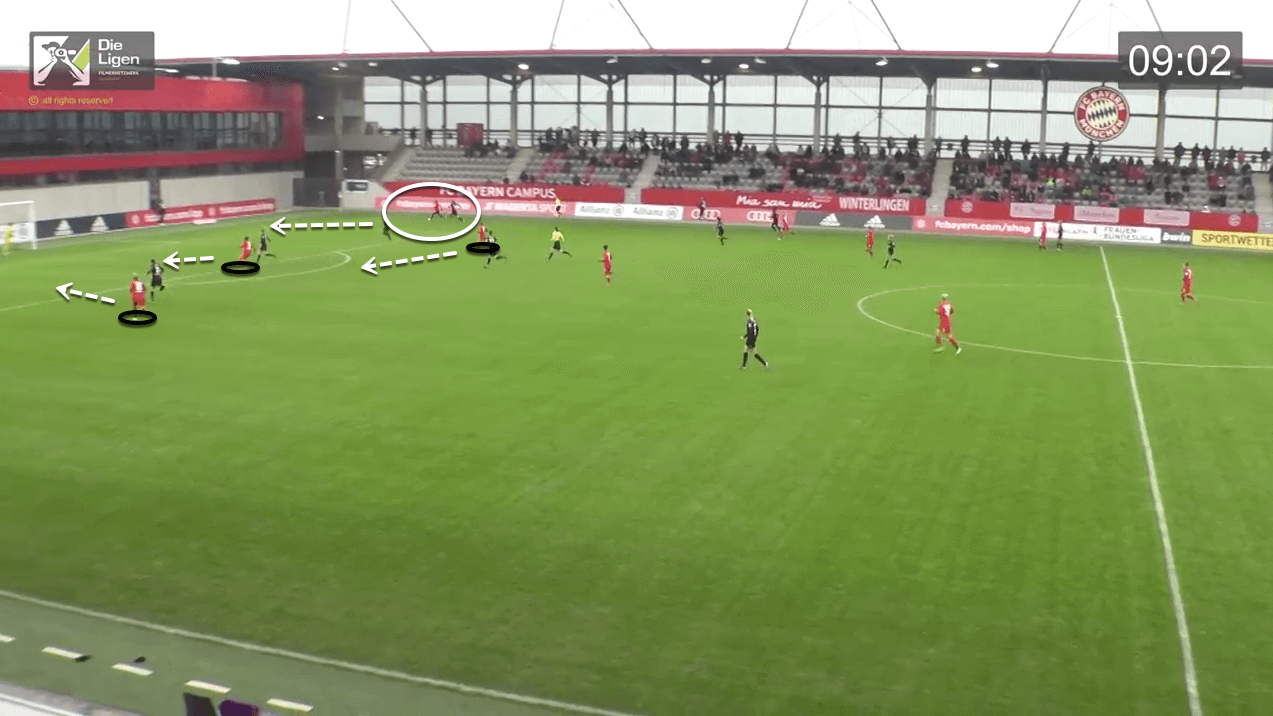
In the image above, Bayern have broken through the opponent’s defensive line down the right flank. The player in possession is quick to move inside to look for a cross. As you can see, there are three teammates moving in for a cross.
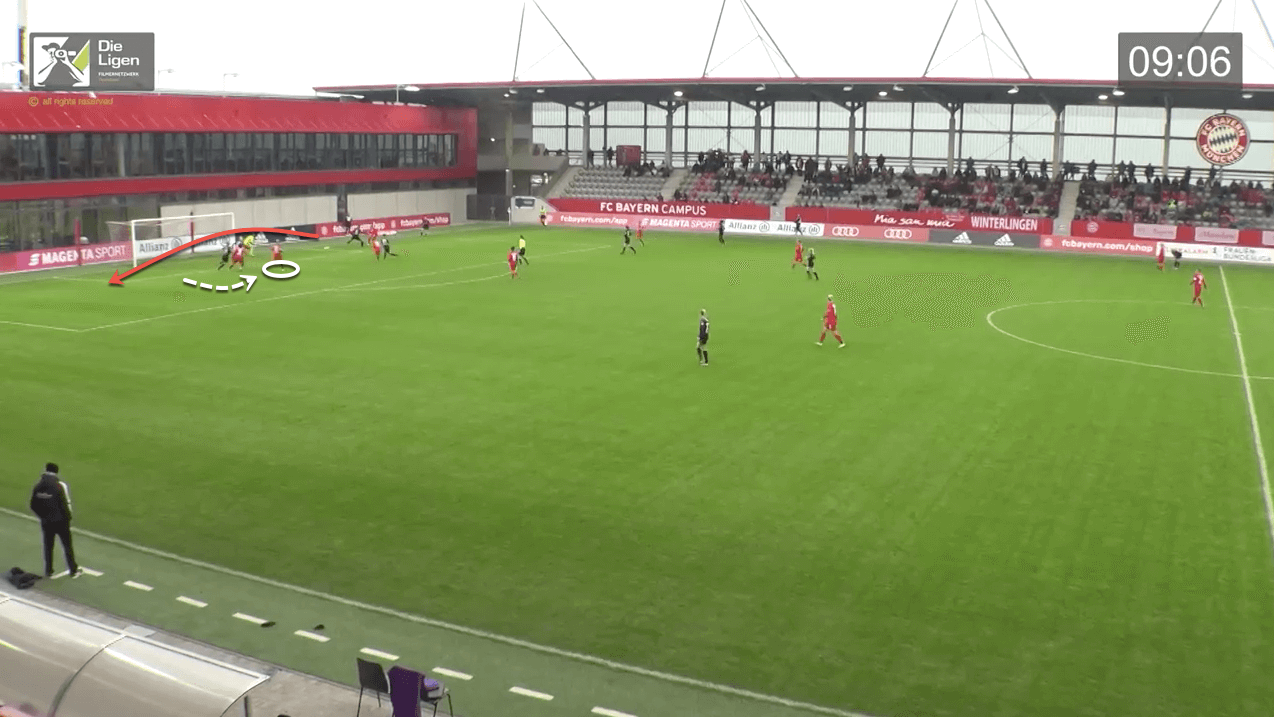
Once she reaches the penalty area, she shoots a cross extremely quickly. It is unable to find a player, however, and goes out for a goal kick.
In the example above, one key part you will notice is a run made off the back of the opposition’s defence. Here, a run has been perfectly timed for a cut back outside of the goal box. However, the player in possession has her mind set on the fast ball across goal, which results in the chance being missed. It is opportunities like these that could make the difference between finishing second place and first place for Bayern Munich.
Conclusion
Bayern Munich are one of the most dominant sides in Europe. They have been hard done by to have a team such as Wolfsburg that takes up the limelight in Germany. The Barvarian side must look for ways to improve, though, as second best in their domestic league will never be viewed as good enough. In this tactical analysis, we have looked at the key tactics that make Bayern as good as they are. We have also taken a look at a couple of places in which there is room for improvement. Changes on both the defending and attacking side of their game such as these could be the difference in finishing slightly ahead of Wolfsburg rather than the slightly behind they have found themselves in three seasons running, as well as look to push on in the UEFA Champions League.






Comments